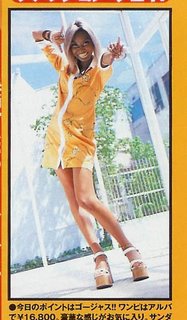Tokyo Graffiti
 Yesterday, in between meeting a man who learnt English on a Navajo Indian reservation and finding a role-playing convention, I bought a magazine called Tokyo Graffiti. This magazine is simply a magazine about life in Tokyo, but it is possibly the most fascinating magazine I have ever read. The fourth link down on the website takes you to images of some of their regular features (too small to read properly), and you can see that they consist almost entirely of pictures of people. An example of the sort of people you can find in Tokyo is given in the picture here, which is of a "Yamanba" girl, or "mountain hag". Yamanba girls wear really sunny clothing, high heels, massive fake tans and white eyeshadow. They often have platinum blond big hair, heaps of jewellery and danglies. Their name is a reference to a Japanese legend about the behaviour of old women who had been cast out of their villages (you can read about it on the web if you care to look). This edition of Tokyo Graffiti had a special couple of pages about Yamanba girls.
Yesterday, in between meeting a man who learnt English on a Navajo Indian reservation and finding a role-playing convention, I bought a magazine called Tokyo Graffiti. This magazine is simply a magazine about life in Tokyo, but it is possibly the most fascinating magazine I have ever read. The fourth link down on the website takes you to images of some of their regular features (too small to read properly), and you can see that they consist almost entirely of pictures of people. An example of the sort of people you can find in Tokyo is given in the picture here, which is of a "Yamanba" girl, or "mountain hag". Yamanba girls wear really sunny clothing, high heels, massive fake tans and white eyeshadow. They often have platinum blond big hair, heaps of jewellery and danglies. Their name is a reference to a Japanese legend about the behaviour of old women who had been cast out of their villages (you can read about it on the web if you care to look). This edition of Tokyo Graffiti had a special couple of pages about Yamanba girls.I shall now present some of the sections from this months Tokyo Graffiti as evidence of how cool it is:
- Ketai shashin o misete kudasai (please show us your mobile phone pictures): in this section 12 people are asked to show the pictures in their phone, which are displayed on a page or half a page of the magazine. A picture of the person is shown, along with a zoom on their mobile phone, a brief description of them, and a pie chart showing what proportion of the photos are from their work, friends, etc. People selected to do this include a foreign English Teacher, a man who works in costume in the electronics' district, a hostess, a host (!), a diver from a southern Island, a housewife and a professional shoot fighter. The pictures are fascinating, and each comes with a tiny explanation (including the house-wife's ferret)
- Old days and now: in this section a group of people presents a photo from many years ago, and then recreate the photo with their mobile phone camera in the modern day. In one photo, 3 children sit at a table in 1985; 20 years later they have reproduced the photo with the same adults in similar clothes, and the same arrangement on a table (right down to the tabasco sauce bottle!)
- Sweet after school: photos and interviews of high school student couples
- obaachan to isho (me and my grandmother): a 20-something woman and her grandmother are photographed side by side in a Tokyo place, standing with their hands at their sides looking at the camera, and each is asked questions about their relationship
- kaku no kazoku shashin (portrait of the nuclear family): a family is photographed naked in a bath or onsen (rock spring), with a brief description
- watashi no heya (my room): photographs of Tokyo residents' tiny rooms with explanations of the room's theme, the most important item, etc. In this month there was also one girl sitting in her room with all her earthquake survival gear and an explanation of its purpose


0 Comments:
Post a Comment
<< Home